Poeticism in Cinema
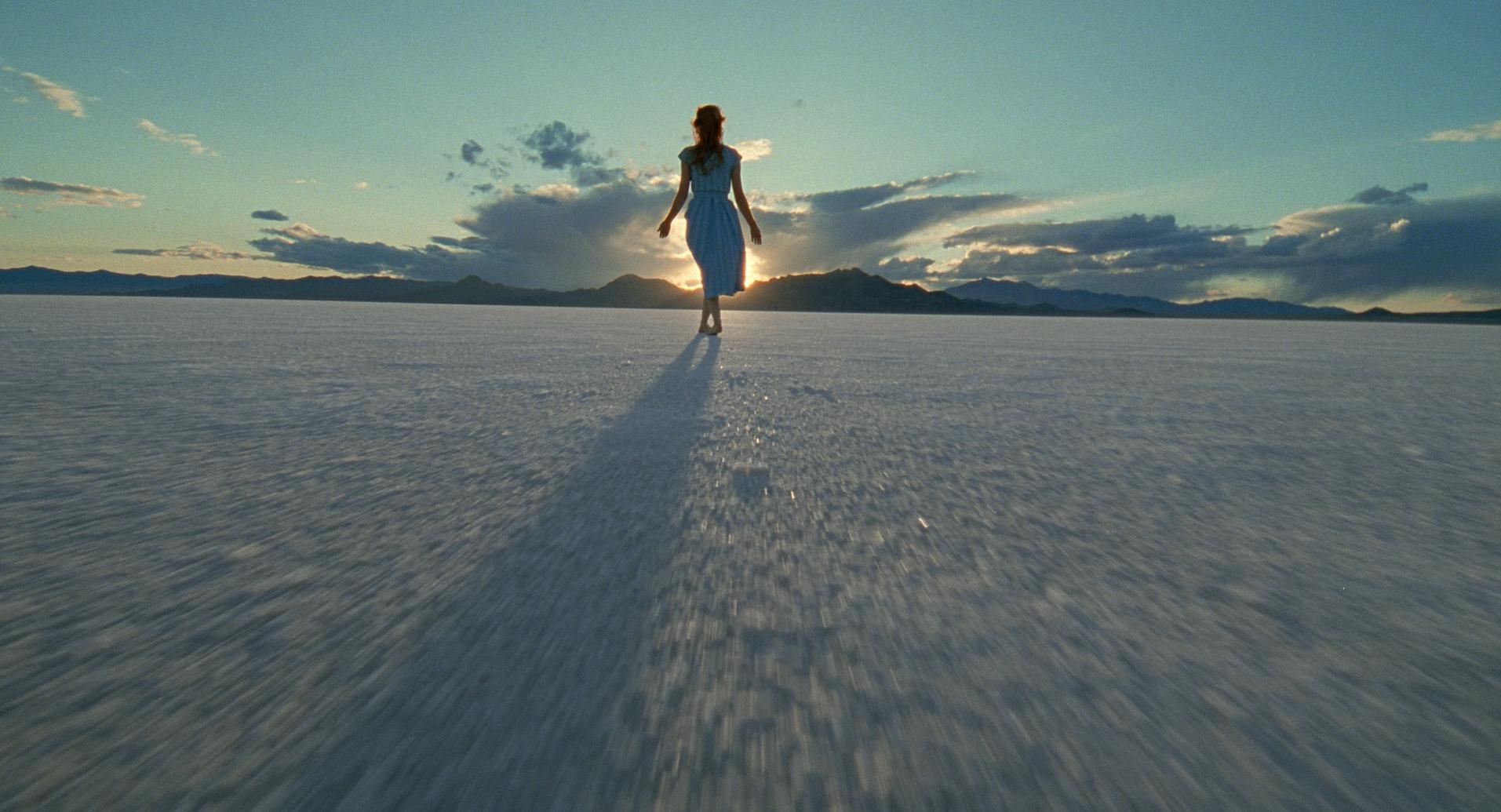
What is poetry? Poetry can be expressed as a form of art in which there is an ocean of abstract mysticism and curiosity, but also a sense of undeniable empathy in context, which is fundamentally relatable material to the reader/viewer. Poetry is a medium of art that perhaps raises more questions than it answers, and resonates heavily within its audience.
How can film be poetic? Some artistic filmmakers incorporate so much beauty, visual storytelling, and music in their films while tackling some very profound narratives, that they are able to elevate their work from a “film” to an “experience.” The epitome of this kind of filmmaking breaks the laws of linear storytelling, and expresses ideas and feelings through the visual and audial; using the senses to both communicate and translate themes. In order to appreciate poetic cinema (or art film in general), an understanding of film’s artistry (not merely it’s entertainment), visual storytelling, storytelling in general, and how directors and cinematographers are able to create meaning using their medium is required.
This article will look at six filmmakers along with some of their greatest achievements, and how/why they are poetic films. Some of these cinematic techniques will range from theme, narrative, visual aesthetic, and music.
This is what film is capable of.
Terrence Malick
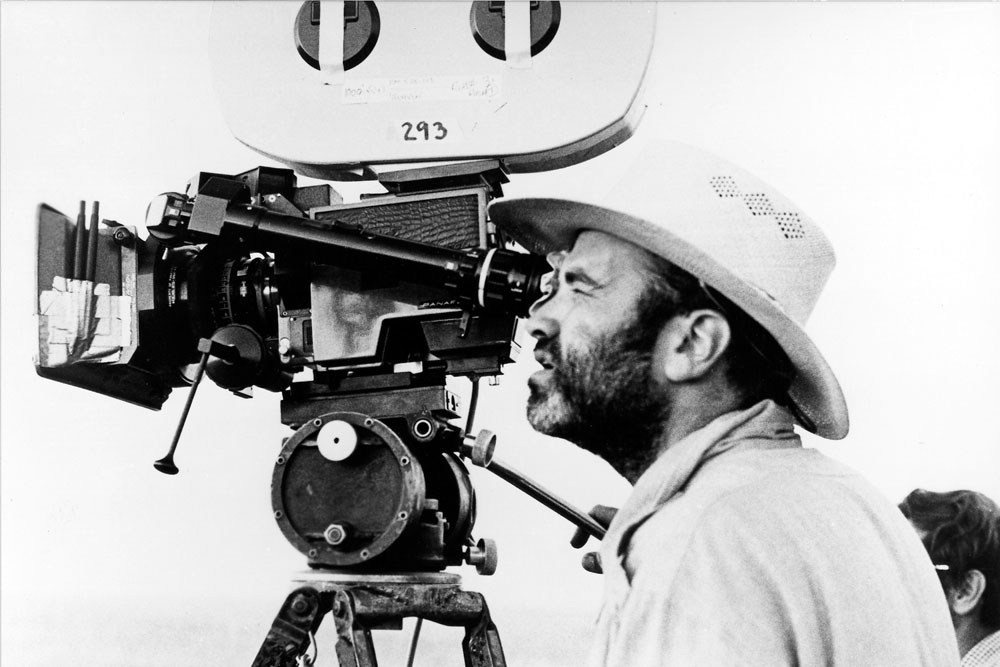
Terrence Malick has captured the awe, grandeur, and spiritual face of the world time and time again throughout his filmography. Undoubtedly, Malick is one of the greatest contemporary auteur filmmakers living today. He introduced poeticism into American cinema more than perhaps any other filmmaker, ever, and has influenced countless other filmmakers such as Christopher Nolan, Alejandro González Ińárritu, and David Lowery. While his career has been spotty, he has time and time again blew audiences away with a classic like The Thin Red Line, and his much more recent work, The Tree of Life. All of Malick’s films, due in part to his signature editing, feel like mosaics of time. They are comprised of quick, beautifully cultivated moments of time in his narrative; all glued together to create a meaning greater than the sum of these parts alone. Watching a “Malickian” (a Terrence Malick-style) story is like watching epic poetry unfold on the screen in a sublime, emotionally-full way. Present in all of Malick’s films, is existential voice over commentaries and speculations from his characters. However, Malick never spells out his ideas through characters talking, but leaves it solely to the visual and audial experience with the voice over commentary to the audience’s interpretation and understanding.

The Tree of Life is undeniably Malick’s most surreal and fantastical film to date (which was technically labelled as a drama/fantasy because of its surreal themes and sequences). The narrative of this film perplexes and baffles audience members to this day, no more so than when it premiered in 2011 winning the Palme d’Or at Cannes. There are two essential stories within The Tree of Life, one of them tracks the seemingly mundanity and growth of a family in small town Texas in the 1950s, while the other tracks the dawn, expansion, and development of the cosmos. Many people wonder why Malick would insert shots of stunning astro-anomalies and gorgeous Earthly landscapes between three boys playing under a sprinkler in their backyard or climbing a tree, but they served multiple purposes. Firstly, a central theme of The Tree of Life is recognizing how lonely human existence is in the face of loss and confusion, and that there seems to be a seemingly infinite weight of cruelty crushing down on seemingly good people. One reason for the ‘world narrative’ is that Malick wanted to show the both brutal and majestic nature of life and how little it regards humans or other forms of life, and another was to literally say that we are made of up indescribable beauty.

This is key when addressing Mrs. O’Brien, who is an angel in the story; which explains why she flies around under a tree at one point in the film. Mrs. O’Brien tells her children to “love every ray of light”, and to “find your own way” between nature and grace. The central idea behind The Tree of Life is about the loss of innocence in this world, and how that crafts what humans are and what they let define themselves. Obviously these ideas come together perfectly from Malick and the film was semi-autobiographical as the setting and father figure in the narrative closely reflect Malick’s own childhood. The film had an uncompromising visual texture to it that defines what this world is to us as a species, and how we grow within it. The Tree of Life is by far the most substantial account of American poetic cinema in recent history.
Andrei Tarkovsky
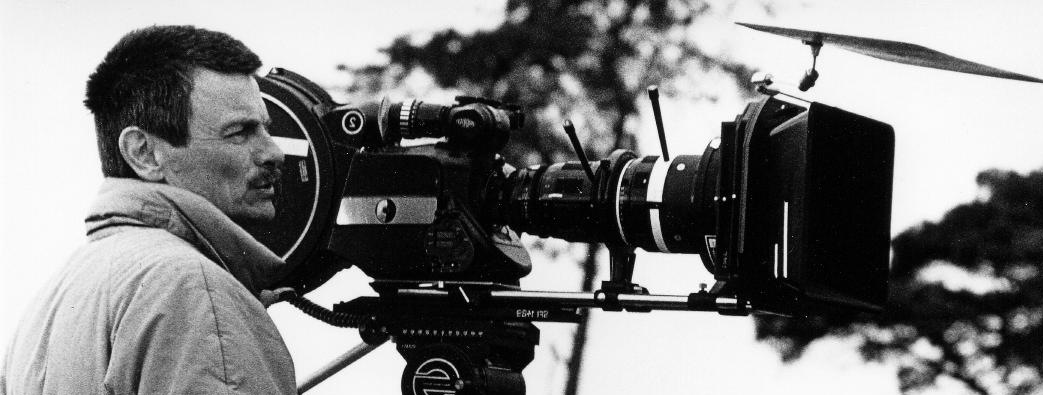
Andrei Tarkovsky, possibly the greatest Russian filmmaker of all time, was much like Stanley Kubrick in respect to grandeur and craftsmanship in his work. Unlike Kubrick, Tarkovsky’s work was much more surreal, poetic, and avant-garde. With every film Tarkovsky made, he astounded audiences with his mind-boggling cinematic techniques and tricks to convey beauty and spirituality in his work. From Ivan’s Childhood (1962) to Solaris (1972), to Nostalghia (1983), and The Sacrifice (1986), Tarkovsky never compromised his philosophy, psychology, spirituality, or cinematic elements to convey meaning. Tarkovsky’s work was extremely metaphysical and influential, to the point where he got his work’s signatures termed “Tarkovskian.” The Sacrifice, written and directed by Tarkovsky, is perhaps his most masterful work. While Tarkovsky is a Russian-filmmaker, his final two films–Nostalghia, and The Sacrifice–were technically Swedish films, as they were made during his time as an expatriate of the Soviet Union.

One signature Tarkovskian quality is having extremely long takes–not only of action, but dialogue. Many times in Tarkovsky’s films, and specifically in The Sacrifice, there will be no cuts in conversations between characters. Often times in his films, Tarkovsky will use ponds, lakes, puddles, any form of water to reflect images and create vast parallels of environment and order. Another prominent feature, is Tarkovsky’s transcendental surreal sequences, none greater perhaps than the ones featured in The Sacrifice. The Sacrifice is about Alexander, an actor who gave up the stage to become a critic/journalist and is living with his family in a beautiful country side house. Alexander professes to a friend that his relationship with god is “nonexistent.” Later, while the family eats dinner, they listen on the television news (and sounds of jets overhead) as a sudden world war has broken out, and could potentially be a nuclear holocaust.
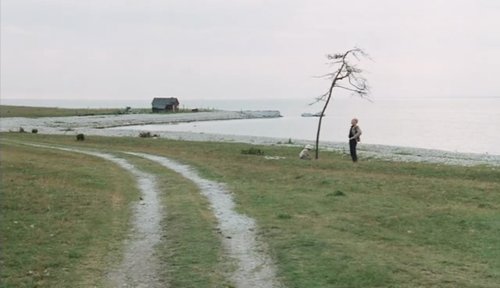
Alexander vows to god to sacrifice all he loves (even his family) for the coming war to be undone. His friend convinces him to have sex with his wife once more. Alexander takes his gun, and finds his wife. After Alexander threatens his own life with the gun, him and his wife consummate while levitating over their bed. This is a prime example of Tarkovsky’s poetry. The film furthers this essence of trouble within humanity and idealism. Tarkovsky is able to expertly contrast the socio-political with a metaphysical and spiritual complex within his characters.
Many biblical references are present with The Sacrifice, along with culturally relevant Russian themes. The film is part-commentary, part-meditation, part-fantasy anecdote. Tarkovsky meant to parallel these contrasting framework’s of narrative to perplex the underlaying subtext within the dialogue exchanges, the character’s roles (in the household, and in the world). Even the location of the family’s house seems to be on some kind of distant land, away from the rest of humanity. Though main idea behind the film is debatable, it is clearly about the nature of faith, being, desire, and how those can come to fruition through human application.
Steve McQueen

Steve McQueen is one of the modern master’s of cinema. While only having made three films, McQueen has proven with each one of his idiosyncratic attention to detail, character development, and beautiful use of music to enhance his film’s experience for the audience. This is the nature of McQueen’s personal poetry in his films. The specific film under dissection here will be his 2011 feature Shame. In Shame–which was co-written and directed by McQueen–Brandon (Michael Fassbender), a sex addict in New York, struggles to manage his cultivated life when his sister suddenly shows up to stay with him. From the opening shot to the final sequence, McQueen completely submerges the audience into the dark world of troubled humanity and taboo desires. Cinematographer Sean Bobbitt used a beautifully melancholic color pallet of blues, purples, moody yellows, and greens to accentuate both the vibrance and mundanity of Brandon’s life.

McQueen also uses voice over throughout the film, contributing to his non-stop pace feeling. Primarily, when Brandon goes through his “unravelling” (ignoring his sister’s call for help, and indulging a loose three-way with two other women), the audience hears a voice mail message left by his sister who seems to be in some kind of personal distress and trouble. As the scene progresses, we watch as Brandon is not actually enjoying the act, as his face turns from appeasement to anguish. During this scene, the extremely emotional score composed by Harry Escott is also used to its maximum capacity: creating a sense of very intense focus from the audience to Brandon. McQueen shoots this scene focusing on the edges of the human body, the curves, the ribs of Brandon as he thrusts and pries into another human, focusing on the moments that Brandon has come to obsess about.
The theme that McQueen attempted to capture with the story is very poetic. While Brandon lives in an extremely ‘free’ environment (New York), he hinders his well-being–traps himself–with sex. He is his own worst enemy; a character of dualistic identity. This idea of being, and existing in a sort of psychological prison, really touches on the essence of the ‘self’ and the nature of personal and interconnected humanity.
Gaspar Noé

Gaspar Noé is one of the great avant-garde filmmakers working today. With all of his films, he challenges the brink of brutality on scene–wether it be violence, sex, or mere content. His writing and directing show in an equal brilliance; furthermore, he parallels the cinematic with the philosophical in a highly dark, existential way. His second feature, Enter the Void, was a harrowing, perplexing meditation on the nature of death, and featured some legendary drug trip sequences. The story follows Oscar, a drug dealer in Tokyo who is killed during a police raid at a nightclub called The Void. From here on, the story is told from Oscar’s perspective in the afterlife, witnessing all the repercussions regarding his death. Meanwhile, his mind travels back and forth through events before, leading up to, and proceeding his death, and the memories of his past. Noé’s distinct visual aesthetic brought an extremely interesting look to the screen. It was immersive, but also carried a very fantasy/foreign feel, rather than portraying realism. The camera would hover through walls, over cities, and through time as the mind of Oscar was unleashed from physical reality. As his spirit moves about, he witnesses the lives of his friends and family, how they were brought together, and how they were torn apart.

In the beginning, Oscar’s friend Alex introduces him to “The Tibetan Book of the Dead”, a buddhist book about the afterlife. On Oscar’s way to The Void, he dialogues and meditates about the nature of the afterlife and it’s relevance to real life. The use of ‘point of view’ in the film is arguably some of the greatest camera work in recent history, combining creative frames, sly visual effects, and unique special effects to bring Oscar’s drug-fueled surreal perspective to life on-screen. Rumor has it that Noé was actually doing cocaine on the set, which would later inspire some of the psychedelic sequences. At one point in the film (in a visual effects sequence), the camera actually goes inside a women, and the audience watches, from the inside, a man penetrate and inseminate her. This is signature Noé cinema. He pushes the boundaries of what is possible to show on-screen.
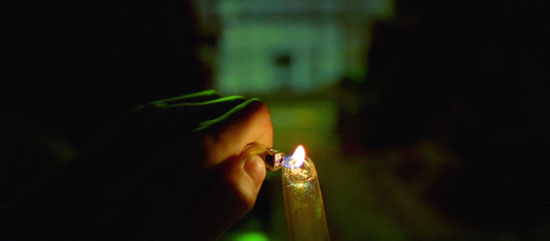
Enter the Void created many metaphors within itself–relating events in Oscar’s life to the actions/reactions of his final decisions, and the courses of his friend’s lives thereafter. The camera stays in this “aerial position” (of Oscar watching over) throughout the remainder of the film, besides his flashbacks to childhood. Due to this non-linear story structure, the events in his life harbor a meaning greater than the sum of their parts. Noé is able to incorporate designed shots meant to insight feelings of distress, loneliness, despair, guilt, and pain throughout this dark landscape of human relations and consequences. The ending of the film was a very thought-provoking “circle” of life metaphor that represents the sentimental side of humanity, along with its vacuity.
Ingmar Bergman
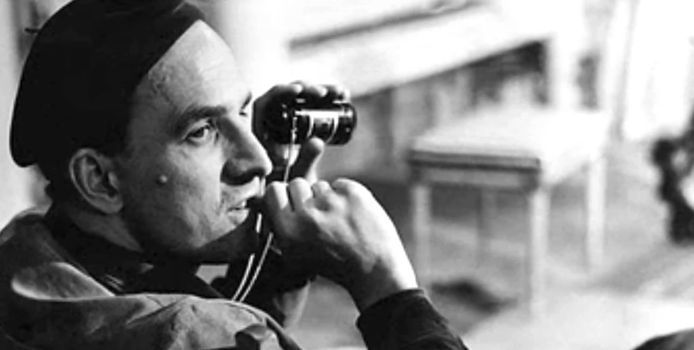
The Virgin Spring was written and directed by Ingmar Bergman in 1960, and to this day remains a legendary art film both receiving critical acclaim and an almost cult-following. The Virgin Spring, follows the story of a virgin girl in a pampered family, who travels along with their jealous pregnant servant to deliver candles to a nearby church. However, events transpire in the woods along the way that would change the course of the family, and perhaps the course of nature as well.
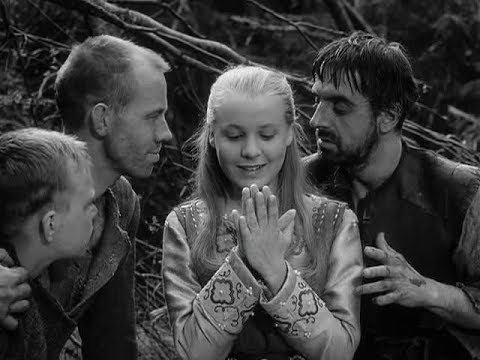
The story centers around powerfully heavy themes and metaphorical characters including a goat, a one-eyed man, a group of three men (two men and one boy), the pregnant maid, and the virgin girl. Bergman shot the film in a graphic black and white aesthetic that renders the grit of the world, and guilt of the characters. Using harsh sensitivity to light, there is a bold contrast through the film. Black and White play a huge role (in all of Bergman’s films) especially in The Virgin Spring. Particularly, Bergman visualizes the virgin girl in a very beautiful, soft way, while contrasting the depths of nature in a very dark and crooked-looking way. There are two central, conflicting forces within the narrative: that of nature’s brute will, and the fragility of humankind’s folly. The question of god comes into play near the climax of the film in which there is a both astounding and nihilistic question of God’s prevalence in the world and his benign relationship with evil. Many suggest that the group of men represent the holy trinity, and the virgin the nature of purity in mankind. Most of the story takes place in the forest–which, in some art forms–has been personified as “The Devil’s Church.”
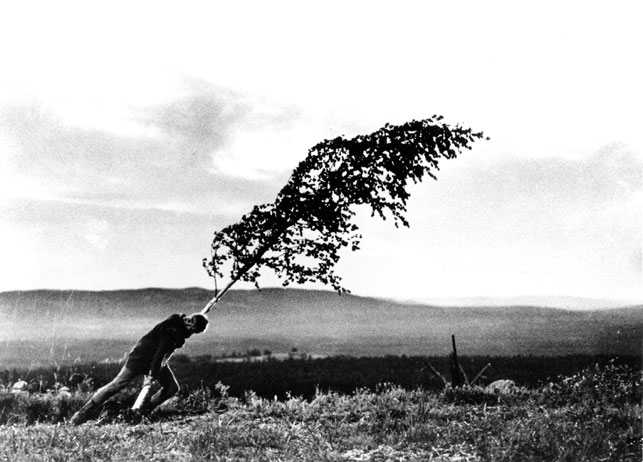
The film, unlike others on this list, features almost no music. There is no comfort or audible overlay throughout the story giving it a bleak and realistic texture. Bergman’s signature poeticism relies on his artistic framing of shots, his metaphors he creates through his editing, and his symbolic portrayal of human beings in hopelessly tragic situations. Many of Bergman’s films are shot out of order, often showing his skill playing with a confused narrative. However, The Virgin Spring is told in a regular form, just like real life. While contrasting grossly spiritual themes revolving around existential questions, Bergman layers the film with a desperate realism that is unmistakably melancholic. The Virgin Spring is one of the most profound films of all time, and perhaps Bergman’s greatest period piece.
Alejandro González Iñárritu
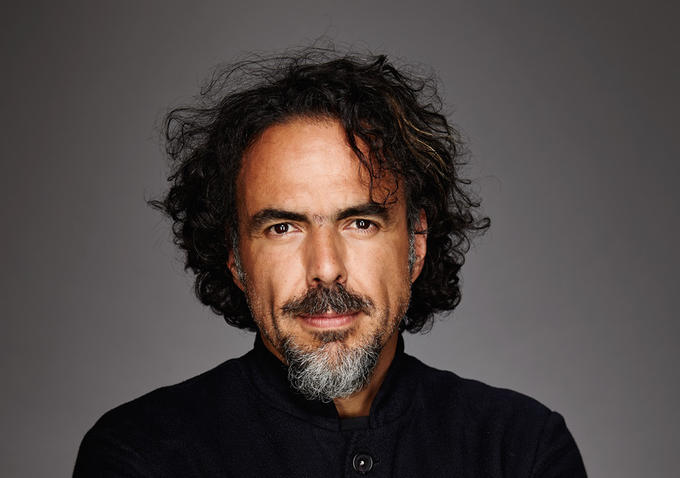
In a short filmography, Alejandro González Iñárritu has created an impressive career for himself, winning awards at both Cannes and The Academy. Iñárritu has incorporated his signature intimate cinematic touch, and flourished it to the grandiose with his latest films such as Birdman and The Revenant. Looking back on his “connected fate” trilogy of films including Amorres Perros, 12 Grams, and Babel, it is clear how much his innovative camera techniques and interesting takes on story structure, character development, and his relationship with the spiritual have solidified themselves in a stylistically voyeuristic way. Iñárritu’s most creative, original, and poetic work to date, is perhaps Birdman. The film won Best Picture, Best Director, Best Cinematography, and Best Original Screenplay in its year, and was also featured in film festivals at Venice, Telluride, and New York. Birdman is one of the most layered and perplexing meta-films in recent years, and Iñárritu’s vision for the film was unlike anything seen before.

On the surface, Birdman is about a washed-up superhero actor, who tries to redeem himself by making “real art” by directing, staring in, and adapting Raymond Carver’s “What We Talk About When We Talk About Love” to the stage. Obviously, the film is a commentary on how hollow of artistic purpose action/superhero movies are, as Riggan (Michael Keaton) argues with himself: ‘you grossed billions of dollars as Birdman/and billions of flies eat shit everyday, does that make it good?’ Within dialogues between characters are many meta-commentaries on the current take of hollywood, the theater, and the pursuit of art, meaning, and success. On another level, is Iñárritu’s magical realistic texture that he told the film in. This is what made it a meta-film. It’s a film, about the making of a play, told in a way that is utterly supernatural–which accentuates the fact that the audience is watching a film. Also, Michael Keaton, in real life, was a washed-up actor after playing Batman. This added a literal realism to the film. In the film, Riggan (Keaton) became popular after the play was a success, and in real life, Keaton’s career kickstarted again after the huge success of Birdman.
With brilliant camera work, the film is made to look like one continuous take, and features many surreal sequences of poetic montages, or action/entertainment vignettes. There are also many references to artistic figures within the film such as Marlon Brando and Shakespeare, and modern actors such as Ryan Gosling and Jeremy Renner. Referencing real life (modern) people, but keeping the actors in the actual story fictitious, adds another level of artistic world-building that Iñárritu does so well.
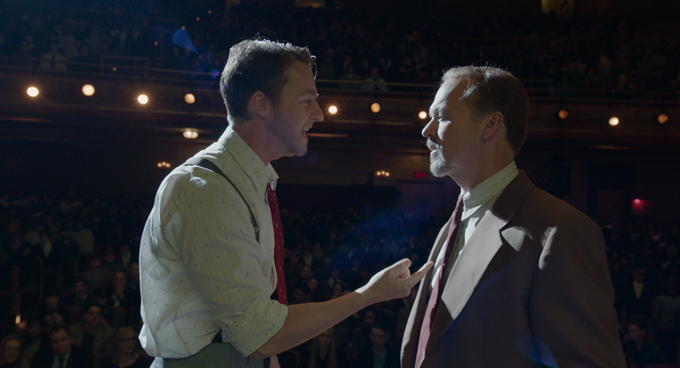
Birdman’s heavier themes about purpose, depression, and fatherhood seep through the story and cause a very dark element to infect the comedic backdrop of the rest of the film. Many ambiguous cinematic motif’s occur throughout the film, such as a comet falling from the sky, a shore-side full of washed up jellyfish, and a surreal montage of street-side New York paraders dressed up as loved action film heroes such as Spiderman and Bumblebee from Transformers. These moments lift Birdman to a transcendental experience not only for those watching, but for the characters and story itself.
Film can be a powerfully effective medium for expressing poetry. Often times, poetic films get a love/hate response. Either people pick up on its powerfully profound and emotional landscapes, or they feel as though it was hollow of artistry or intention. Art is subjective, but likely, there is an argument to be made for meaning and quality found in art films because, likely, the filmmakers behind the production probably approached the medium from an artistic, visionary background.
The root of poeticism in cinema stems from the immediate emotional response that cinema derives, and the abstract ideas that cinema is capable of connecting, and making metaphors therein. Poetic cinema is an elite breed of art film that demands an attentive audience, but can also leave a wonderfully profound feeling within the audience as well.
This is what film is capable of.
What do you think? Leave a comment.











Wong kar-wai?!
I reall love Kar-Wai and In the Mood for Love is one of my 3-4 favorite films ever.
Movies on this article are good and interesting, but I think that every good movie is poetic. If it’s not poetic it isn’t worth a dime.
Love Malick, Kawase and Mehrjui.
The word “poetic” can only apply to literary forms that manipulate sound as a source of meaning. Visual arts cannot be poetic. Sincerely, an English and film professor at ASU.
If “poetry” can only apply to the written medium, how do you account for the musical form of Symphonic Poetry or Tone Poetry, pioneered by composers such as Franz Liszt, Bedrich Smetana, and Carl Loewe?
At least, in the sense that you’re using the word. You’re attempting to draw a non-existent parallel.
Thanks GG, for clearing this up…I am on board with you in a technical sense of what “poetry” or “poems” are…however, some things may be referred to as “poetic” as a synonym for beauty, as I’m sure you are aware…
I have only seen two of the referred to films…”The Thin Red Line” which I wasn’t impressed with and “Birdman” and in this case…I would be tempted to refer to the cinematography as “poetic” or perhaps (e)motionful poetic cinematography…
Great article. I learned a lot.
“This is what film is capable of.” I just . . . yes. Thank you.
Thank you for the overview of these films. There are some on here that appear to be very interesting from a visual aspect.
Wonderful work! Iñárritu is an intriguing director, I’ve found.
Really informative, this helped me get the last bit of info I needed for my exam notes, thank you!
Holy Mountain is a great poetic film.
I would add Charles Laughton’s Night of The Hunter as a film that is very poetic.
I would enourage people to check out Abderrahmane Sissako’s films Waiting For Happiness and Timbuktu. Both are extremely poetic films.
I would have liked to see Koyaanisqatsi here.
Thank you for the profiles on some very talented film makers.
Interesting piece.
Days of Heaven.
Some of the greatest film-makers and I wish more people were familiar with their life and work.
These films are of the best films in the world.
They are deep about the meaning… not just actions, explosions, women…
Thank you for this.
Some kind of dreamy beauty in Malicks films.
Anyone who’s ever tried to write a screenplay knows that it can be completely frustrating, not only in terms of story and structure but also because of the sheer difficulty of conveying action on the page. You literally have to write what you see. You sort out the images in your head and pick the ones that really matter and capture the essence of a scene, a mental distillation process of sorts. All of these filmmakers are masters at what they do.
Great post.
Wonderfully written article. As defined, poeticism hinges on empathy, and is thus subject to the tastes and preferences of every viewer. Good to keep in mind that films with clear narratives can be just as poetic as abstract ones.
Surely the cinema was at its most poetic in the black and white film noir period.
I agree. They displayed most of the criteria one would apply to poetry and could be emotionally and visually overwhelming.
The fact that film can reproduce an experience that we may or may not be able to verbalize (I usually cannot), while at the same time throwing us deeper into the world in which we live (as Malick does), is fascinating. Great piece.
luminousgloom,
I’m not sure how much I enjoy poeticism in movies. That isn’t to say poeticism DOESN’T exist in movies; it certainly does and the filmmakers you talked about in the article certainly show it in their work.
My problem is that movies are, for me, primarily a storytelling medium, not an artistic medium. I am much more likely to enjoy a film that lacks serene visuals but presents a coherent and engaging storyline with thoughtful themes and vibrant characters than a film that supplants storytelling with interpretive visuals.
For example, I recently watched two movies more or less back to back; The Hateful Eight and The Revenant. Without a doubt, The Revenant was the prettier of the two, making a whole lot more of it’s surroundings than The Hateful Eight did. But with that said, I think The Hateful Eight was a much better movie on account of it’s playful narrative that constantly kept me engaged. The Revenant’s pretty landscapes, though impressive, only did one of two things to me: lulled me into boredom or, more often, made me want to go on a walk so I could see actual landscapes.
But, okay, The Revenant was made by an artsy director and is meant to be an artsy picture, so I’ll cut it some slack there. Where I can’t cut it slack is in the colossal plot hole that sinks the entire movie for me. The Chieftan in the movie was looking for his daughter Powaqa, and he traded with French fur-trappers for information pertaining to her whereabouts and horses to go find her. Yet we learn later that the French fur-trappers were the ones who had kidnapped the girl. This unfortunately means that the Chieftan and his daughter are hopelessly dumb seeing as how neither one bothered to find the other; Powaqa could’ve easily screamed for her father to help her OR he could’ve asked the French trapper if he’d could look around their camp for a bit to try to find her. Worse yet, the writers then imply that the Chieftan HAD SOLD Powaqa to the French trappers; in the scene when Hugh Glass (DiCaprio) stumbles upon their camp later in the movie, one of the French trappers is heard saying, “Bring me that girl. Those five horses weren’t free,” heavily implying that the Chieftan (or one of his tribe) had traded the girl for the horses. This is truly bad writing that could’ve easily been remedied had Inaritu just shown us a quick scene of Powaqa being kidnapped or perhaps her struggling to tell her dad that she was being held by the trappers. But instead, he decided to make an arty movie short on story rather than a narrative-driven movie short on art. And what do you know; of the two wintry-Westerns that came out early this year, the one with a clearer, tighter story won me over.
It’s not like I can pretend that arty movies don’t exist or that some of them don’t have value (I thoroughly enjoyed Gravity, Interstellar, and Bridge of Spies, all of which had great, moody atmospheres), but overall, I think the movies that have the most value to me and which stick in my mind the longest are those that put story first and art second.
Thanks for your time and for the thoughtful article,
August
Cinematography is not simply about making beautiful images, it’s about creating meaning therein (ie: visual storytelling). If a film has no visual storytelling then it should not be a film. If you’re not going to use the medium of film to tell the story, why are you making a film of it? Because it’s easier to watch a movie than read a book?
This argument of ‘these films are tooo artsy’ seems to be problematique. Saying a film suffers because it’s too “boring” is engaging in one of two outcomes. (1) The viewer didn’t pick up on the visual storytelling, so it was like they were looking at nothing, hence the bordom, and (2) the objection is invalid: it should not be the artist’s job to appeal to the audience; rather, the audience should try and understand the artist.
As for your plot hole with The Revenant, it isn’t relevant, since that is a flaw with the writing and not the artsy-ness of the film–despite you creating an association with the two.
luminousgloom,
You’ve raised some solid points. I’m going to do my best to address them all, but please reply if I’ve let some slide or if there any others you’d like to bring up.
First off, as you said, cinematography isn’t about shooting nice images, but by creating meaning in them, which I think can adequately be described as presenting visual metaphors. And you’re also right when you say that movies, by definition, should have visual storytelling in them, otherwise why not just write a book. The problem for me is when the visual metaphor becomes too abstract or out of place, which leads me to think that there isn’t any meaning in the scene.
Lets take two scenes, one from The Shawshank Redemption and one from The Tree of Life. In the former, Andy escapes out of a tube filled with human waste and when he finally reaches the outside world after serving 10+ years in prison for a crime he didn’t commit, it’s raining. He tears off his clothes and lets the rain wash over him. That is a very clear visual metaphor; the crapper-tube symbolizes him having to go through years and years of abuse at the hands of guards and inmates alike, his tearing off of his prison garment symbolizes his shedding himself of his guilty past and the rain symbolizes his cleansing of Shawshank. He emerges both spiritually and physically (or to use technical terms, metaphorically and literally) a clean man.
Now for The Tree of Life. There’s a scene that comes out of nowhere that depicts a house submerged in water and a bunch of kids swimming out of it. To put it bluntly, I have no idea what that means. It obviously wasn’t meant to imply that their house had literally been flooded, but at the same time, I can’t pick up on any transcendent meaning. Is it a metaphor that shows how stifling their childhood was, because that message was presented much more clearly in the scenes when Mr. Obrien was teaching them to live up to his expectations. Is it meant to imply that time erodes things? Jack’s narration did a better job of explaining that as well. To me, it comes off as a useless scene because there were other scenes that presented it’s supposed messages better than it did. While I got that the film was about the eternal battle between transient, physical nature and transcendent, spiritual grace, I only got that because of Mrs. Obrien’s narration, not because of any visual.
Again, while you are right that movies, by their inherent nature, are meant to have visual storytelling present, that doesn’t mean that cinematography is the only element at work in them. Even Malick, Tarkovsky, and Bergman (who I’d say are the most surreal/abstract filmmakers on your list) wrote screenplays for their movies which included moments of dialogue, and what are screenplays if not a form of writing that is meant to be expressed in the movie? And how about the composer? He has to write music that invigorates the audience’s emotions. While I used to think that cinematography was the most important element at work in a movie, I’ve since come to think that it is not; even though it’s still the primary element at work (seeing as how movies can only be shot/shown through a camera/projector) it is the means by which other elements of the film (primarily the dialogue) come through. Perhaps it’s simply best to say that I tend to enjoy a movie’s spoken metaphors over it’s visual metaphors. That obviously puts me in a corner in terms of your why not just read a book objection, but I suppose it’s just a personal preference.
Also, I’d never expect any artist in any medium to try to meet up to my standards. It would be ridiculous to ask a filmmaker, writer, or composer to craft pieces of work that make me and only me happy. Obviously they should present their art in whatever way they wish. However, this respect goes both ways: if a filmmaker, writer, or composer makes something that doesn’t stir anything in me or serves to only baffle me, they should not expect me to flatter them, nor should they expect me to look for something that isn’t there. I very much admire and am deeply moved by Steve McQueen’s films (who, consequently, I think is the best director on your list) because I can see meaning in them. Malick and Tarkovsky, while certainly capable of crafting imaginative and sometimes memorable scenes, never get me as involved in their movies because I can’t always see what their driving at. Some people say that’s the point, that some movies are just meant to confuse you instead of enlighten you, but honestly, I think that’s a roundabout way of saying, “I don’t get it either.” All too often that leads me to dislike the movie even more seeing as how it makes the director come off like they’re privy to some secret knowledge that we lowly folk are simply incapable of grasping.
Lastly, your point about The Revenant; while you’re right in saying that the movie’s poor writing wasn’t CAUSED by the movie being arty, it seems to me that Inaritu neglected his writing because he chose to focus more on the visuals and opted to tell the majority of his story visually, and to my mind, his writing suffered as a result of that choice. I have no doubt that the order of his concerns when making the movie went visuals first, writing second. Going back to the previous point, he is free to make his movie any way he wants, but I’m free to raise objections about mistakes I’ve seen, and while the objections I have aren’t about the visuals specifically, they certainly affect my thoughts on the work as a whole.
I appreciate this dialogue, I thank you for starting it, and if you wish to continue it, I’m all for it.
August
I am reminded of Paul Schrader’s book on what he deemed transcendental film style. Unlike the style of psychological realism, which dominates film, where story may dominate the proceedings, the transcendental style expresses a spiritual state with austere camerawork, acting devoid of self-consciousness, and editing that avoids editorial comment.
I see some similarities in your article – in particular, your examples all speak to acknowledging more to the world of the characters – something greater than them that might only be expressed in a poetic way.
The departure of a poetic cinema departs – as you have beautifully laid out -from a transcendental style with what I would call “flourish”. Each of the directors you have named use cinematography or voice over and other filmic elements to, if not editorialize, to evoke. To stir resonations of meaning.
A great article! Interesting to take poetry something seeming so literary and applying it to film
Thanks for that article! I think it’s important to not be too academic about what poetry is to keep it reachable and universal as a term. I see it as a glimpse into a more interconnected perspective on life, as it makes us connect words or images that seem to be unrelated, hence the art of metaphor. The film “Baraka” by Ron Fricke does a wonderful job at that, despite the lack of narration. The sequences by themselves bring the idea, by purely visual means, that all life is one at a deeper level.
From my perspective this article does a good job of capturing and shifting what it means to be “poetic” from the literary to the cinematic. “Poetic” as defined by a use of verse rather than prose is terminology which functions well regarding more avant-garde approaches to cinema, as it paints an accessible picture for the ways in which certain film techniques are capable of disrupting narrative continuity.
I’ve always disliked the idea that movies are only narratives and so your article about the poetic nature and more thoughtful or thematic approach that films can take was, for me, a breath of fresh air.
I did find it curious though that you left out editing as a relevant cinematic technique. And that you didn’t touch on documentary, which offers it’s own version of more poetic filmmaking.
Very good list. Even in this highly commercialized era of cinema, there are still many directors devoted to quality film aesthetics. McQueen and Inarritu are especially important now, for their recent successes in award seasons have illustrated that there is still a respect for such poeticism in the Hollywood mainstream.
I think someone like Shane Carruth could be added to this, especially after Upstream Color.
Bergman was a good choice for this. I am not familiar with the others.